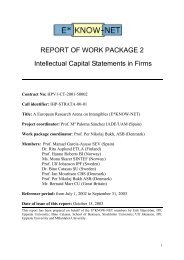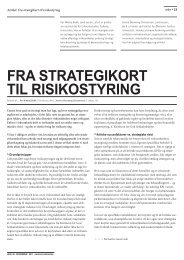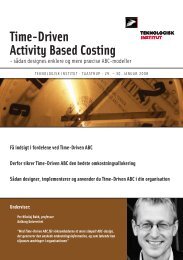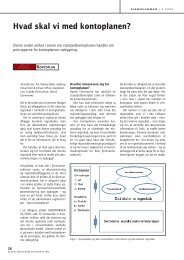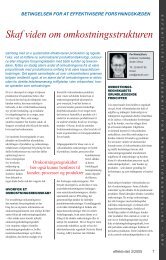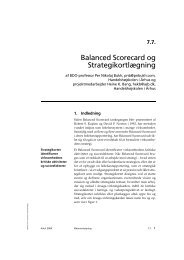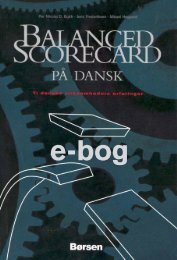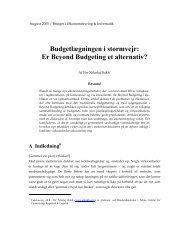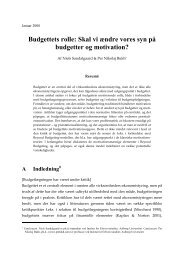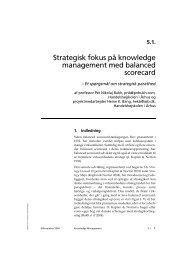guidelines for managing and reporting on intangibles (intellectual
guidelines for managing and reporting on intangibles (intellectual
guidelines for managing and reporting on intangibles (intellectual
Create successful ePaper yourself
Turn your PDF publications into a flip-book with our unique Google optimized e-Paper software.
are likely to affect those resources. Finally, the firm should define the support activities<br />
that allow an adequate m<strong>on</strong>itoring <str<strong>on</strong>g>and</str<strong>on</strong>g> follow-up of all the intangible activities <str<strong>on</strong>g>and</str<strong>on</strong>g> their<br />
impact <strong>on</strong> crucial <strong>intangibles</strong> resources.<br />
As a result of the identificati<strong>on</strong> process, a network of <strong>intangibles</strong> emerges, providing the<br />
firm with an accurate picture of current critical intangible resources, of those that need<br />
to be developed in the future, <str<strong>on</strong>g>and</str<strong>on</strong>g> of the activities related to its strategic objectives (see<br />
Figure 2).<br />
Figure 2. Network of <strong>intangibles</strong><br />
STRATEGIC OBJECTIVE<br />
CRITICAL<br />
INTANGIBLE 1<br />
CRITICAL<br />
INTANGIBLE 2<br />
CRITICAL<br />
INTANGIBLE 3<br />
INTANGIBLE RESOURCES<br />
INTANGIBLE RESOURCES<br />
INTANGIBLE RESOURCES<br />
INTANGIBLE ACTIVITIES<br />
INTANGIBLE ACTIVITIES<br />
INTANGIBLE ACTIVITIES<br />
At the top of the breakdown, we find a set of critical <strong>intangibles</strong> that might help<br />
maintain or enhance a firm’s competitive advantage or attain its strategic objectives.<br />
These critical <strong>intangibles</strong> are abilities the firm has or needs to develop. Examples of<br />
critical <strong>intangibles</strong> are: Adaptiveness to market changes, Human Resource commitment,<br />
Innovative capacity, <str<strong>on</strong>g>and</str<strong>on</strong>g> Customer approach.<br />
A c<strong>on</strong>crete example of that breakdown using the c<strong>on</strong>cepts defined in paragraph 50, can<br />
be found in Figure 3. The example is a very simple <strong>on</strong>e, where the three columns of<br />
resources <str<strong>on</strong>g>and</str<strong>on</strong>g> activities refer to <strong>on</strong>e of the established categories of <strong>intellectual</strong> capital.<br />
For example, highly educated people <str<strong>on</strong>g>and</str<strong>on</strong>g> training activities are related to human capital,<br />
patents <str<strong>on</strong>g>and</str<strong>on</strong>g> R&D expenditures are linked to structural capital, <str<strong>on</strong>g>and</str<strong>on</strong>g> loyal customers <str<strong>on</strong>g>and</str<strong>on</strong>g><br />
an increase in direct marketing are tied to relati<strong>on</strong>al capital. It is important to note that<br />
the breakdown may change over time, as the company may identify different intangible<br />
resources <str<strong>on</strong>g>and</str<strong>on</strong>g> activities to manage at different points in time.<br />
Similarly, it may be the case that not all intangible resources are assigned the same<br />
relative importance in terms of management <str<strong>on</strong>g>and</str<strong>on</strong>g> m<strong>on</strong>itoring. Some can be c<strong>on</strong>sidered as<br />
crucial <str<strong>on</strong>g>and</str<strong>on</strong>g> deserve special attenti<strong>on</strong> whereas other may be deemed less important, but<br />
will still need to be managed <str<strong>on</strong>g>and</str<strong>on</strong>g> accounted <str<strong>on</strong>g>for</str<strong>on</strong>g>.<br />
15



